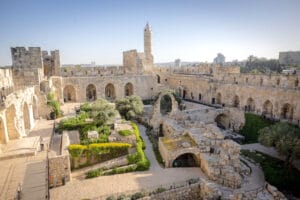Tucked inside the Jaffa Gate of Jerusalem’s Old City stands an edifice that personifies the resilience of Israel’s eternal capital. The Tower of David has served as a Herodian fortress, a Crusaders’ palace, an Ottoman entrance gate, and now hosts the renewed and state-of-the-art Tower of David Jerusalem Museum.
The $50 million renewal and conservation of the museum, thanks to Dame Vivien Duffield through the Clore Israel Foundation, the Jerusalem Municipality and other philanthropic funding, has transformed a compound designed to keep intruders out to carefully plotted galleries filled with exhibits that explore and trace the history and the spirit of Jerusalem.

The Tower of David, near the Jaffa Gate entrance in the Old City of Jerusalem. Photo courtesy of the Tower of David Jerusalem Museum.
Turning the ancient structure into a modern and accessible museum was a formidable challenge for the architects and design team on the project. Using all the original architecture, except for one ceiling, they transformed the first-century fortress into a welcoming, comfortable, and handicapped-accessible modern museum with 215,000 square feet of galleries detailing Jerusalem’s 4,000-year significance to Judaism, Christianity and Islam.
After 10 years of planning, three years of construction and the installation of a mile of fiber optic cables, the museum, originally founded in 1989, officially opened on June 1, with an additional contemporary art gallery opening in November.
According to Caroline Shapiro, director of external affairs for the museum, the new flow that begins adjacent to the Jaffa Gate takes visitors through the museum in a way designed to showcase the city of Jerusalem. It still offers shady outdoor areas where tour guides gather their groups or where visitors can meet before beginning their exploration.
Diverse Audiences
Curator Tal Kobo and her seven core team members combined actual artifacts culled from the site during excavations by teams of archeologists during the renovation with 3-D touch screens, mounted carefully to highlight the stone walls behind the glass.
Eilat Lieber, chief curator of the museum, understood the nature of the diverse audiences she had to reach, after her son took a school trip to the museum prior to its renovation and pronounced it “boring.” History, he said, is boring. She pondered how to make it relevant to our time—and to the many different communities that converge in Jerusalem.
Appreciating The History
“We decided to use an interactive process,” she explained. “We have the perfect location, and this building represents all the layers of history and of conflict,” she said. “We realized that the evidence of the past will tell the story in different ways and engage visitors to find what is meaningful to each different person. The Tower of David is one of the most beautiful and well-preserved fortresses in the world. The history of Jerusalem must be told through technology and beautiful design.”
With headsets and audio tours, her son came back on a class trip to experience the “new” museum. This time he didn’t say boring. “This,” he said, “is cool!”
The technology team for the museum comprised more than 50 people in five separate studios.
Hiding Technology
The designers chose a clean, minimalistic look to contrast with the heavy stone structure and enhance the power of the site. Even the cracks between the stones were conserved. Grouting was replaced by limestone. Elevators and ramps were installed.
“The two elevators were six years of heated discussion with the antiquities commission,” recalls professor Tal Roih de Lange of Studio de Lange, one of the designers.
“The important design principle was to maintain context with the city,” he explained. “Each space is different in both architecture and context. “Communication cables, electric wires and even lighting fixtures were carefully hidden.”
But how do you light 215,000 square feet of castle without beams and ugly cables strung across the ancient ceilings?
The architects and designers met the challenge using “floating” cement floors with LED lighting in between the crevice between floor and wall. Heating and cooling emanates from under the floors as well. Small but powerful sconces inserted in the limestone cracks between the stones were used to augment the natural lighting of the vaulted ceilings. The glass displays light up as well, offering effective and dramatic interaction.
And don’t think the acoustics in a castle are optimal. According to Architect Yotam Cohen Sagi, they used 3D scans to conduct acoustic studies and tried three different materials until they were able to ensure that the sound traveled properly throughout the galleries.
“I have never been on so many site visits and to so many meetings for a project,” Sagi explained. “There were so many layers, and we used old fashioned methods of measuring and leveling—holding strings. And then, just when you think you know what you’re doing, you find ancient remains or artifacts and have to stop everything and call in the Israel Antiquities Authority,” he said.
Engagement
Every window and skylight is visible. At one point the visitor looks through a display and a window beyond the exhibit highlights the modern city of Jerusalem. History connects with high-tech Jerusalem itself.
All the 3D models face in the actual direction of their orientation, transporting the visitor to their exact location within the space of the museum. As large as each space is, the exhibits are designed to keep visitors engaged, without fatigue from the constant content. The technology is designed to communicate various content in different ways. Transparent touch screens allow 360-degree close-ups of real artifacts located in nearby cases in one space. Another space lends itself to ceiling projections, and another to multimedia presentations.
The first gallery offers 3,000 years of history in three minutes—a multimedia presentation by Israeli cinematographer and Golden Globe winner Ari Folman. Through classic animation and video mapping, it traces the history and culture of Jerusalem.
Maps And Audio
A “Bunting Map” from the Middle Ages portrays Jerusalem as the center of the world, flanked by Europe, Asia and Africa; the city on the shores of eternity. As you progress through the gallery, it’s like being in a time tunnel, with a 40-foot-long interactive wall fueled by 12 computers.
As you progress through the Mamluks and Ottomans and finally find the interactive 3D globe, you are brought to almost the present time with a letter from Israel’s first president, David Ben-Gurion, to a young boy
If you enjoy maps, there are 14 interactive ones on offer, including an elevation map of Jerusalem, enhanced by special lighting and a 2.5 minute video that displays the entire city.
Don’t forget your audio guide (it’s in three languages). As you progress through the museum, it will tell you what you’re looking at, because at some point, it can become overwhelming. You will see a five-and-a-half-minute film by Jerusalem filmmaker Yair Moss, and Dale Chihuly glass exhibits adjacent to cannonballs from the Jerusalem revolt in days of yore.
Each religion is given its due. The Jewish room features the mosaic of Bet Alpha’s Binding of Isaac and a large model of the Second Temple, complete with artifacts from that period, including a coin press for Hasmonian coins and a first-century lily coin. A Yeshiva University-created 3D scan of the Arch of Titus has been colorized and animated, capping off the Jewish exhibit.
A Jordanian Madaba Map with crusader coins features the Tower of David on the coins, with some featuring the Crusader kings and queens who took up residence in this very castle.
Accessible?
Underneath the minaret, which served as a mosque at various times during the city’s history, there is a large model of the Temple Mount complex, featuring the Al Aqsa Mosque and a cutaway of the famed Dome of the Rock. For those of us who have never been near or inside it, it is illuminating to see the Foundation Stone and other features of the Mount.
“With all its layers and incarnations, the Tower of David has never been a ‘holy place,’ explains Tal Kobo. “But the artifacts and the history symbolize the yearning to come back to Jerusalem.”
For children who still think “history is boring,” in addition to all the displays and visuals, every room is equipped with interactive games and quizzes for children. For the older generation and for those with special needs, the museum is one of the most accessible attractions in Jerusalem.
“We had to get permission for everything,” explained Reut Kozak, accessibility coordinator for the museum. “From hanging signs to buildings and structuring the floors. The Mamluks didn’t make the doorways wide enough for wheelchairs,” she said.
All told, only 15% of the museum is not completely accessible, she added.
Famous for its light shows at night, the new museum will feature noise reduction headphones and relaxed performances for people on the autism spectrum or who have sensitivities to sound. An app uses Bluetooth to access hearing aids for the hearing impaired and customizes the sound for each ear, and there are audio descriptions for the sight impaired.
A sensory map provides a guide that details dark, light and the noisier rooms, and there is an audio tour guide for sight impaired. There are visuals with sign language on the app for the hearing-impaired.
The only area not accessible to anyone who cannot navigate the final 50 steps is the observation deck, but the museum has created a virtual reality experience for those left behind that will help them enjoy the 360-degree panoramic view from their phone.
And, thanks to the new flow, when you come out of the Tower of David, through what used to be the original entrance, the Old City is at your feet, ready to be explored in real time.








